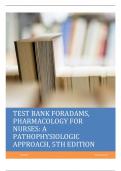2.
The nurse administers a vaccine to a child. What is the best understanding of the nurse as it relates to the manufacture of this vaccine?
Exam 1
CHPT 1, 2, 3, 4, 5, 12, 13, 20, 21
1. The vaccine is produced by natural plant extracts in the laboratory.
2. The vaccine is naturally produced in animal cells or microorganisms.
3. The vaccine is produced by a combination of animal and plant products.
4. The vaccine is most commonly synthesized in a laboratory.
Answer: Correct Answer: 2
Rationale 1: Vaccines are not produced by natural plant extracts.
Rationale 2: Vaccines are naturally produced in animal cells, microorganisms, or by the body
itself.
Rationale 3: Vaccines are not produced by a combination of animal and plant products.
Rationale 4: Vaccines are not synthesized in a laboratory.
Global Rationale: Vaccines are naturally produced in animal cells, microorganisms, or by the
body itself. Vaccines are not synthesized in a laboratory. Vaccines are not produced by natural
plant extracts. Vaccines are not produced by a combination of animal and plant products.
Cognitive Level: Applying
Client Need: Physiological Integrity
Client Need Sub: Pharmacological and Parenteral Therapies
QSEN Competencies: III.A.1 Demonstrate knowledge of basic scientific methods and
processes.
AACN Essential Competencies: IX.3 Implement holistic, patient-centered care that reflects an
understanding of human growth and development, pathophysiology, pharmacology, medical
management and nursing management across the health-illness continuum, across lifespan, and
in all healthcare settings.
NLN Competencies: Knowledge and Science: Integration of knowledge from nursing and other
disciplines.
Nursing/Integrated Concepts: Nursing Process: Evaluation
Learning Outcome: 1-4 Compare and contrast traditional drugs, biologics, and complementary
and alternative medicine therapies.
MNL Learning Outcome: 1.1.1 Apply basic concepts related to pharmacology.
Page Number: 4




